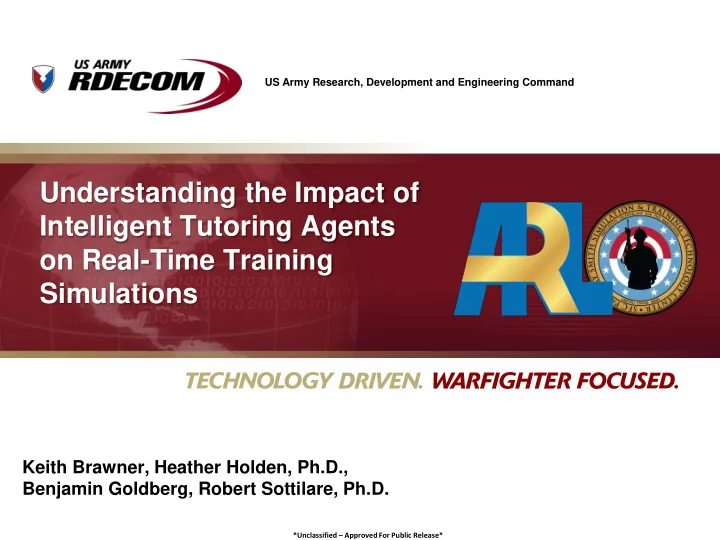

US Army Research, Development and Engineering Command Understanding the Impact of Intelligent Tutoring Agents on Real-Time Training Simulations Keith Brawner, Heather Holden, Ph.D., Benjamin Goldberg, Robert Sottilare, Ph.D. *Unclassified – Approved For Public Release*
Presentation Roadmap • General Notes on Intelligent Tutoring • Reactive techniques of automated instruction – Strategies and successes – Limitations • Active techniques – Strategies and successes – Limitations – Promise • Direction of the field (Future work) – Military – Civilian SFC Paul Ray Smith Simulation & Training Technology Center 2 *Unclassified – Approved For Public Release*
Words on Intelligent Tutoring System Design • Typically approach well defined domains • Adapt content to skill level • Have turn-based, or event-based approach • Built within a tightly coupled environment SFC Paul Ray Smith Simulation & Training Technology Center *Unclassified – Approved For Public Release*
Reactive (Computer-based) Strategies and Successes • Scale the content to the user’s ability – User takes in more content in a shorter time • In specific domains, more effective than traditional instruction • “Is Adaptive Learning Effective” Literature review – 15 systems, average effect size .95 – Includes math, programming, physics, natural sciences SFC Paul Ray Smith Simulation & Training Technology Center *Unclassified – Approved For Public Release*
Reactive Limitations • Domains are not always well defined • Cannot expand to social tasks, or team training • People are more than performance ability – Human tutors ask questions – Respond to stalls – Account for motivation • Fundamentally, these tutors do not know “how to teach” • Result? Observation of ½ of the human tutor effect size SFC Paul Ray Smith Simulation & Training Technology Center *Unclassified – Approved For Public Release*
Active Strategies and Successes • 50% of (human) tutor interactions are based on affective elements – D’Mello , Taylor, Davidson, & Graesser, 2008 • Tutor-Learner relationship is social/trusting, which aids in cognitive development – Kim & Baylor, 2006 – Woolf et. al., 2009 • Proactive human tutors have been observed to improve performance – Two standard deviations SFC Paul Ray Smith Simulation & Training Technology Center *Unclassified – Approved For Public Release*
Active Strategies and Successes • Carnegie Learning’s Cognitive Tutor – Realtime feedback based on continuous assessment • Autotutor – NLP responses based on content and cognition • Conati educational game – Tracks user emotional state SFC Paul Ray Smith Simulation & Training Technology Center *Unclassified – Approved For Public Release*
Active Limitations • Everything must be realtime • Requires a step beyond the content creation – Time consuming, expensive • Feedback for a specific state is a relatively novel problem – Learning in a stressed state • Incorrect decisions have negative impact – Razzaq & Heffernan, 2009 • Lessons Learned: – Do not break flow – Do not distract the user SFC Paul Ray Smith Simulation & Training Technology Center *Unclassified – Approved For Public Release*
Active Promise • Team Training • Ill-defined Domain Training • Leadership Training • Emotional or Stress Training SFC Paul Ray Smith Simulation & Training Technology Center 9 *Unclassified – Approved For Public Release*
Field Direction - Civilian • Computer-based Intelligent Tutors work: (Woolf, 2011) – Effectively reduce the time required for learning by 1/3 to 1/2. – Networked versions reduce the need for training support personnel by about 70% and operating costs by about 92% Woolf, B.P. (2011). Intelligent Tutors: Past, Present and Future. Keynote address at the Advanced Distributed Learning ImplementationFest, August 2011, Orlando, Florida. SFC Paul Ray Smith Simulation & Training Technology Center 10 *Unclassified – Approved For Public Release*
Field Direction - Military • TRADOC FY 12 Warfighter outcomes – T-3. Adaptive Training System – T-5. Tailored / Adaptable Learning and Training (includes Intelligent Tutor) • TRADOC S&T White Paper themes – Intelligent Tutoring Systems • TRADOC Force Operating Capabilities – FOC-10-01 Leadership Training & Education – FOC-10-03 Realistic Training SFC Paul Ray Smith Simulation & Training Technology Center 11 *Unclassified – Approved For Public Release*
Questions SFC Paul Ray Smith Simulation & Training Technology Center *Unclassified – Approved For Public Release*
Recommend
More recommend